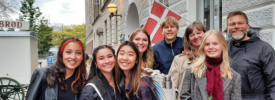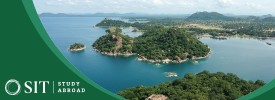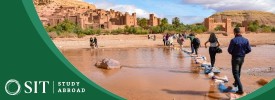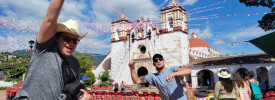Tokyo: Big City, Big Adventure Past Review
By Elissa S (Asian Cultures and Languages (Japanese), The University of Texas at Austin) for
Sophia University: Tokyo - Direct Enrollment & Exchange
I learned more about aspects of Japanese daily life, gained lots of cultural and historical knowledge, and became slightly more proficient in the language. This enables me to better understand the material I read in class and will be valuable in my pursuit of a written translation career.
Personal Information
| How much international exposure did you have prior to this program? | 0-2 weeks |
Review Your Program
|
* Overall educational experience
Academic rigor, intensity, resources, etc. |
My professors did a lot of things to encourage outside exploration of Tokyo, sometimes even volunteering their spare time to guide us there. The system is less fluid sometimes, and I really disliked how many of the exchange students tested lower than their level with the proficiency test. When we tried to request we be placed in the appropriate class they pretty much refused every time. I ended up retaking the equivalent of UT's second year Japanese program. |
|
* Host Country Program Administration
On-site administration of your program |
Lots of support services, but they weren't always willing to give students the right to choose their language program (I feel they stuck too strictly to the results of the proficiency test). Lots of classes to choose from, decent class sizes. |
|
* Housing:
How satisfied were you with your living arrangements? |
You will need to bring your own linens/towels, but often times there are dishes/glasses/trashbins left by previous tenants. Some people may even get lucky enough to get a rice cooker or a television. It took about 20-35 mins to get to class by train, which is very decent for Tokyo (and better than the 40-60 mins it took for the kids living in Saitama). The neighborhood was very safe and quiet. |
| * Food: |
The food was delicious and overall more healthy than the average American diet. Enough options even for vegetarians. Even McDonald's is more tasty in Japan. Try their seasonal/limited time meals, they're usually really interesting! |
|
* Social & Cultural Integration:
How integrated did you feel with the local culture? |
Nothing was arranged by my actual program, but I enjoyed the things I did together with my profs like going to kabuki theater and a trip to an izakaya. |
|
* Health Care:
How well were health issues addressed during the program? |
|
| * Safety: |
The program had English speaking staff in the health services office and a list of English speaking health providers for problems more serious. I didn't need any specific vaccines but I did make sure to get my flu shot before I left. |
| If you could do it all over again would you choose the same program? |
Yes
|
Finances
|
* Money: How easily were you able to live on a student's budget?
(1 = not very easy/$200+ on food & personal expenses/week, 2.5 = $100/week, 5 = very easily/minimal cost) |
|
| Do you have any general money-saving tips for future study abroad participants? | Most of the money I spent was daily necessities. Just shop around for the best/cheapest places to eat depending on your neighborhood. Local/family owned places are usually the best and most affordable. |
Language
| * Did your program have a foreign language component? | Yes |
| How would you rate your language skills at the beginning of the program? | Intermediate |
| What was the highest level language course you had completed prior to departure? | JPN 412L |
| If applicable, to what degree did your living situation aid your language acquisition? |
|
| Language acquisition improvement? |
Students, neighbors, teachers... just about anybody since English is not a national language in Japan. It can be difficult to get even the Japanese students to speak Japanese to you, because they want to practice their English with you. |
Direct Enrollment/Exchange
| * Did you study abroad through an exchange program or did you directly enroll in the foreign university? | Exchange |
Other Program Information
|
* Where did you live?
Select all that apply |
|
|
* Who did you live with?
Select all that apply |
|
|
* Who did you take classes with?
Select all that apply |
|
A Look Back
| * What did you like most about the program? |
|
| * What could be improved? |
|
Individual Course Reviews
| Course Name/Rating: |
Japanese 2 |
| Course Department: | JPN 112A |
| Instructor: | Koizumi, I. and Konishi, K. |
| Instruction Language: | English/Japanese |
| Comments: | It wasn't very challenging as I'd already taken the class equivalent in America. The teachers were knowledgeable but sometimes weren't as prepared because we would move through all the prepared materials too quickly (half the class was placed lower than they should have been). I participated more in class because I was already confident in the material. There were no field trips. |
| Credit Transfer Issues: |
| Course Name/Rating: |
Development of Japanese Civilization 1 |
| Course Department: | HST 251 |
| Instructor: | Bettina Gramlich-Oka |
| Instruction Language: | English |
| Comments: | The course had it's challenging moments in analyzing some of the materials and being able to establish thoughtful links between them, but it was very interesting. Prof Oka encouraged us to go out and explore Japan by having us split into groups and creating projects discussing places we visited (our group did Kawagoe-shi). |
| Credit Transfer Issues: |
| Course Name/Rating: |
Survey of Japanese Literature |
| Course Department: | ALIT 3310 |
| Instructor: | Mathew Thompson |
| Instruction Language: | English |
| Comments: | Lots of encouragement to discuss the readings, and prof was always willing to provide cultural context when we had questions. Professor also offered to help me with my paper in one of my other classes (it involved a play we read in this class) and arranged to guide students at museums on some weekends. |
| Credit Transfer Issues: |
| Course Name/Rating: |
Issues in Japanese Thought |
| Course Department: | HST 439 |
| Instructor: | Bettina Gramlich-Oka |
| Instruction Language: | English |
| Comments: | LOTS of outside reading and a really difficult final (20 page research paper!) but it was a very interesting class. The professor encouraged exploration of relevant places in Tokyo (I visited Sengakuji, the temple where the 47 rounin and their master are buried) and took us to a kabuki performance (Kanadehon Chushingura). |
| Credit Transfer Issues: |








